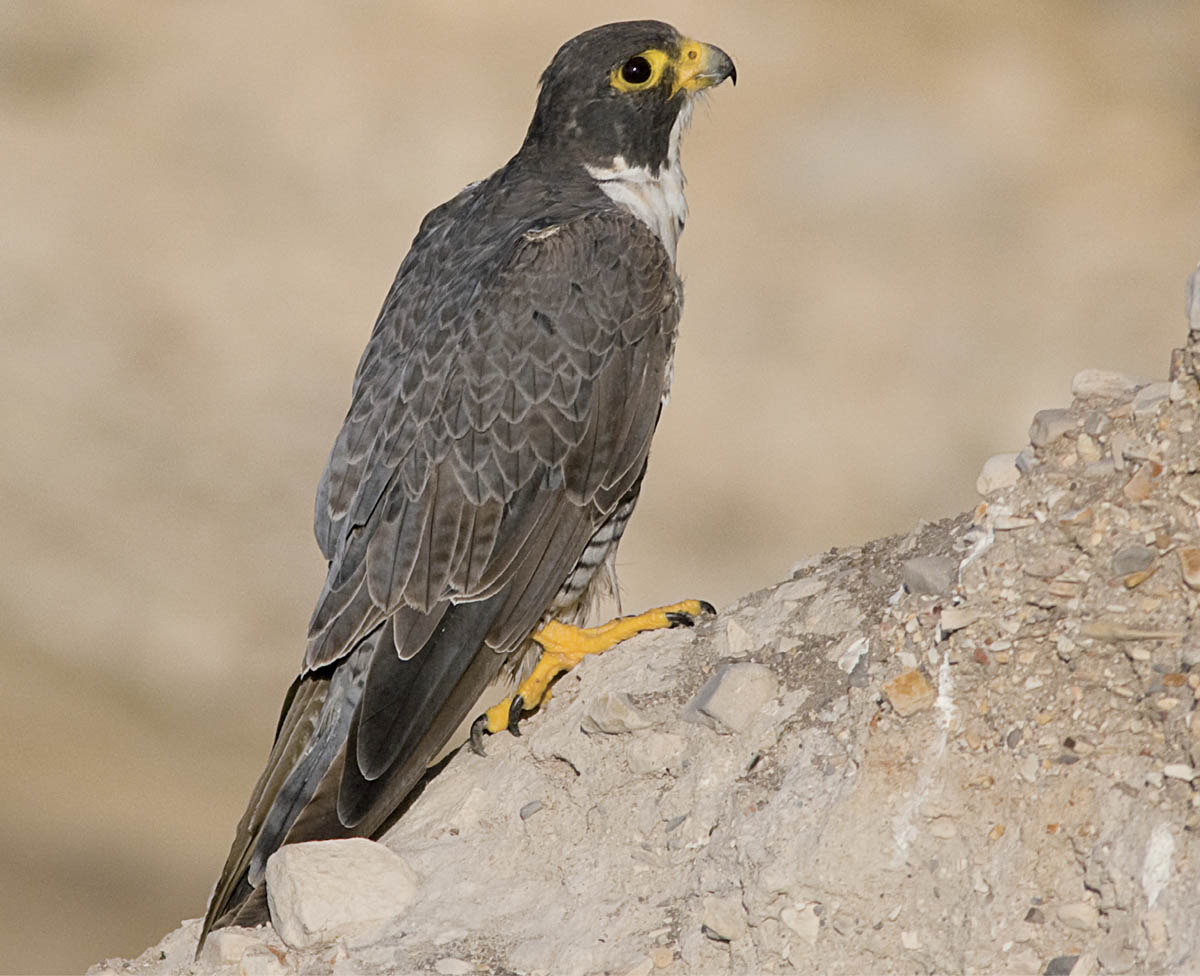
Peregrine Falcon adult male
The fastest known bird in the world, the Peregrine Falcon was on the edge of extinction in the 1970s. DDT was one culprit, resulting in extremely thin-shelled eggs that didn’t hatch. Humans also killed peregrines to protect their racing and messenger pigeons. But thanks to the work of researchers and falconers, the species is now thriving — an iconic example of the success of the Endangered Species Act when a species is given full protection and research and management to restore it are fully funded.

Peregrine Falcon adult male
For many centuries, peregrines have been a favorite choice in the ancient sport of falconry, which has its own terminology: the female peregrine is simply a falcon, the male is a tiercel, and a nestling is an eyas (plural eyases). This long history means that wild as well as captive-bred and reintroduced Peregrine Falcons are more thoroughly understood than other birds of prey.
The most migratory peregrines nest on the Arctic tundra and winter in South America, traveling as far as 7,000 miles every spring and fall, often through countries with few protections for migratory birds and weak environmental safeguards. Many reintroduction programs try to release birds from other populations that will not leave North America in winter.
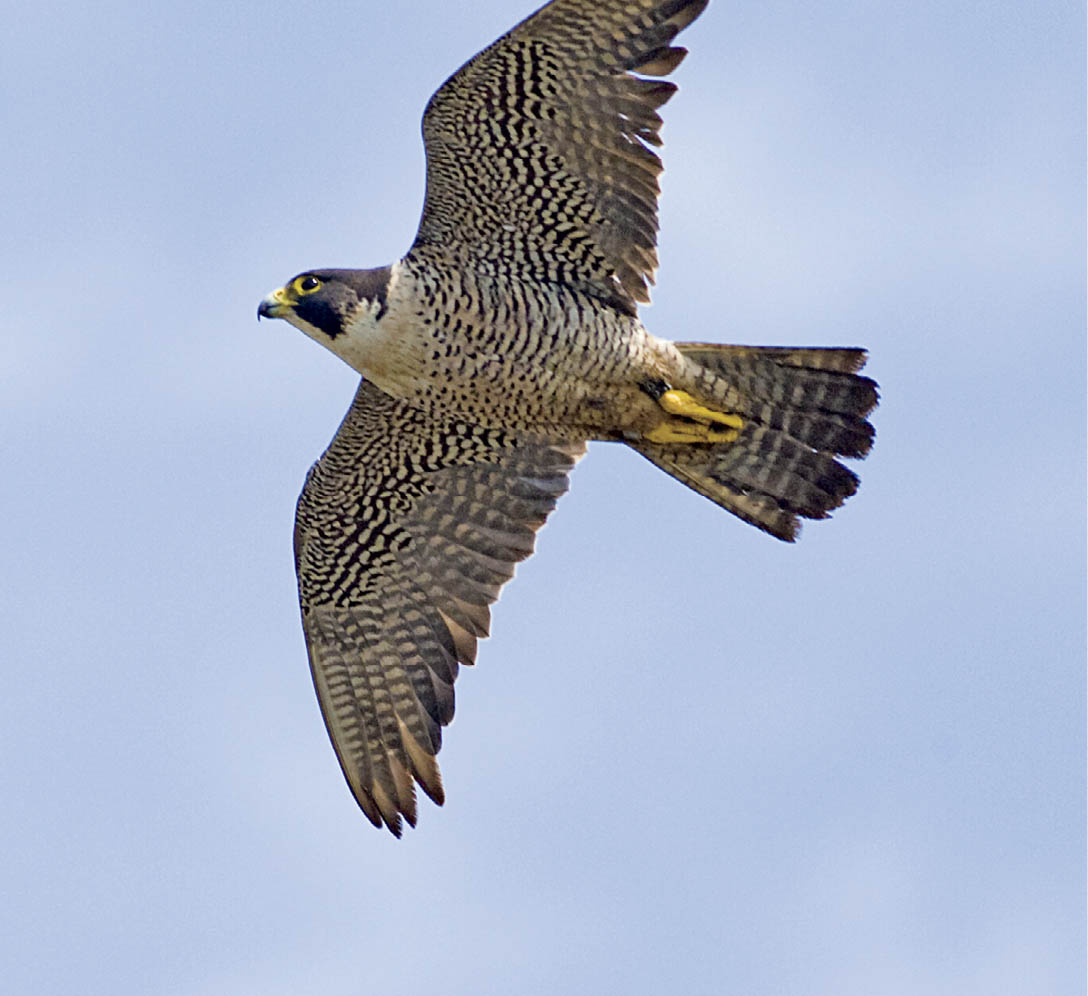
A Peregrine Falcon flies over its nest site. Early in the breeding season, the male (or sometimes the female) claims a nest site and attracts a mate by giving aerial displays. While soaring high above the nest cliff,the bird gives a wailing call.
As courtship begins, the male peregrine is usually first to claim a cliff, ledge, or nest box. If unattached, he perches prominently near the site, frequently making a loud advertisement wail. When a female flies in, the two perch side by side, peep softly, gently nibble each other’s bill or feet, and preen one another. Soon they will perform head bows and a variety of displays.
The male may start several nest scrapes, but both birds complete the chosen one, squatting and pushing the material backward with their feet. Even when peregrines reuse an abandoned stick nest, they still go through the same scraping motions. This functions the same as nest-building in other birds, helps cement the bond between the pair, and prepares them physiologically for egg and sperm production.
Before copulation and egg-laying, the pair engages in thrilling aerial displays, soaring in loop-the-loops and figure eights. The acrobatics may include fight playing, in which they lock talons, touch breasts, momentarily lock bills, or simply tag one another in flight. The male also feeds the female in flight.
The pair starts hunting cooperatively. At first they search for prey at some distance apart, but soon the male begins diving at flocks of birds as the female circles above. If one bird breaks off from the flock, the female stoops, grabbing it at high speed.
The smaller male is faster than the female and more agile in flight. He does most of the hunting for the family during incubation and while nestlings are tiny. The larger female is better suited for protecting the nest against intruders; her heft also helps with heat transfer during incubation and brooding and gives the male a bigger platform for balancing, his claws pulled in, during copulation.
After about two weeks of copulating, the female begins laying eggs. Her body probably doesn’t ovulate until there’s certainty that the eggs will be fertilized.
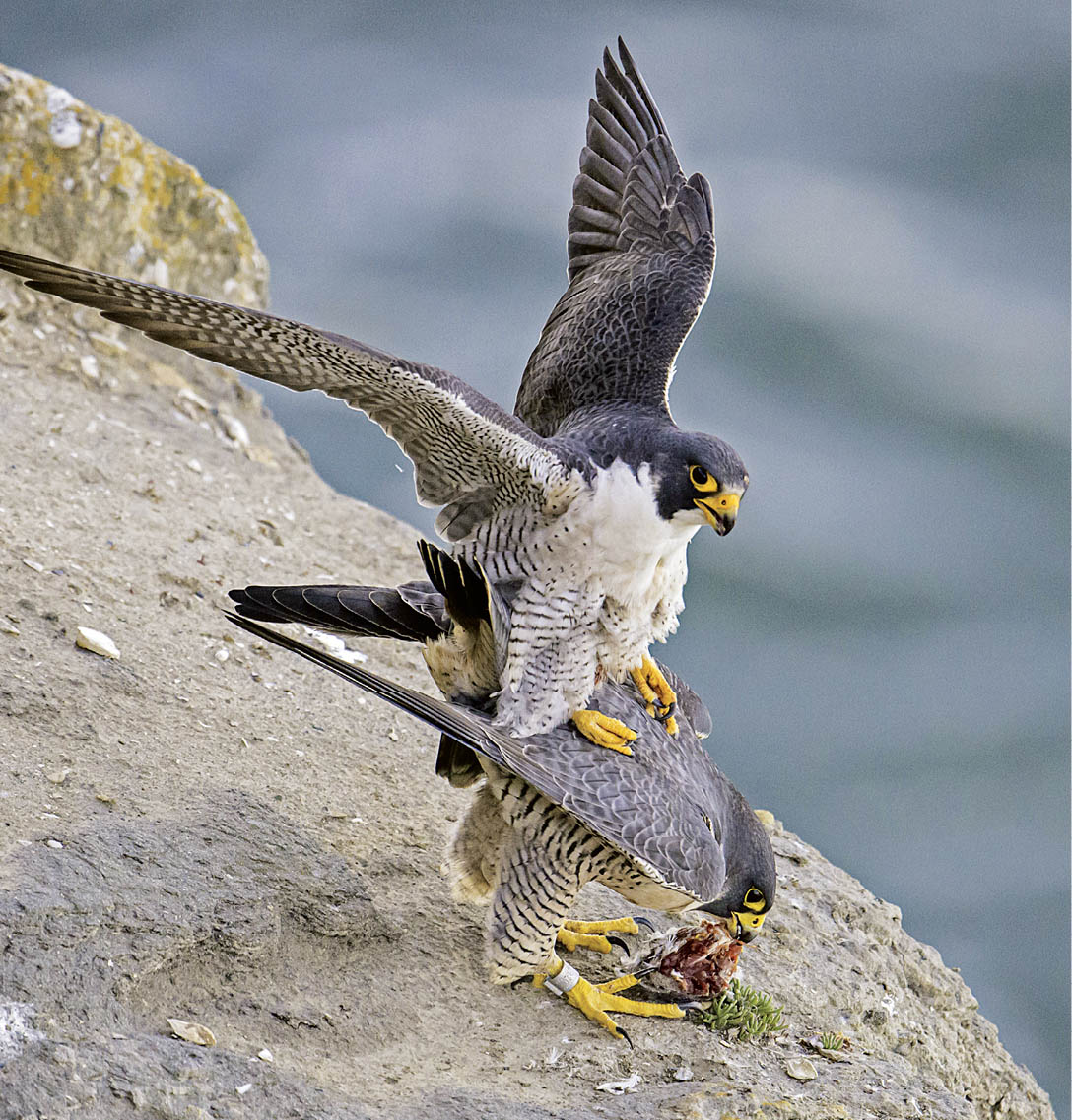
A peregrine female snacks on prey brought by her mate while he copulates with her on a ledge near their nest site. While mating, the male makes chittering sounds and the female emits wailing calls (unless she has her mouth full of food at the time).
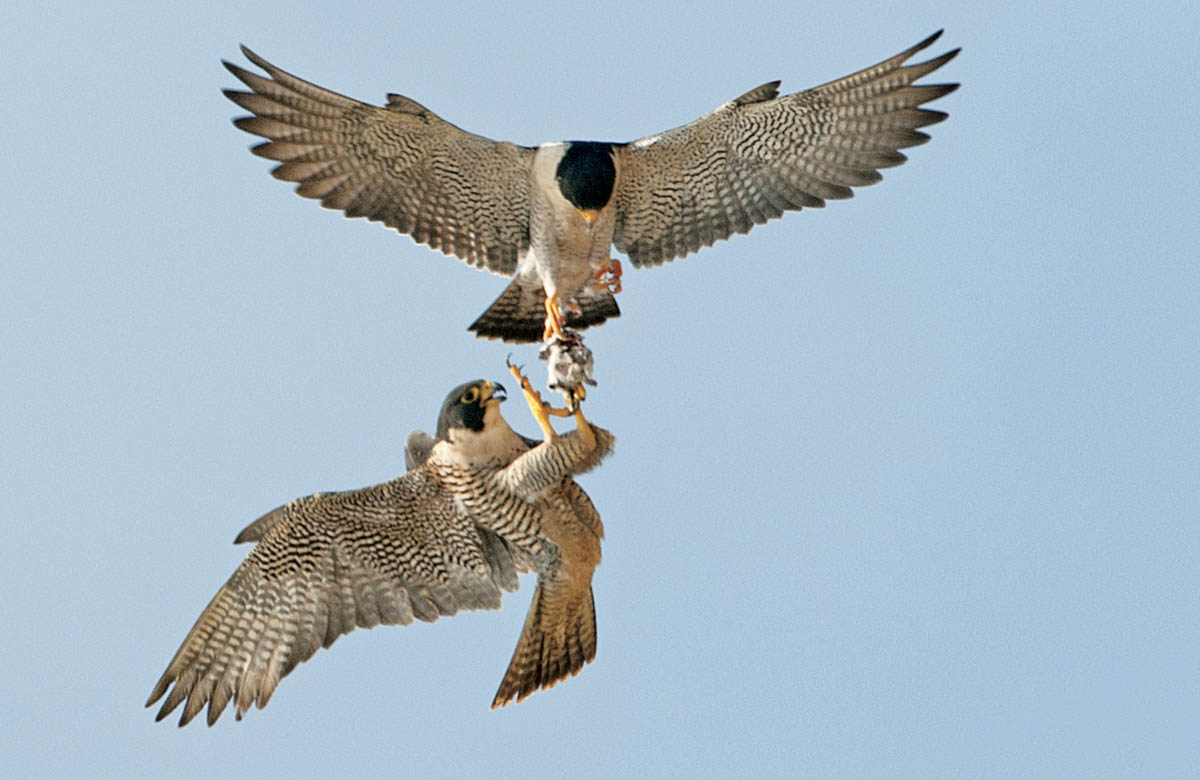
A courting pair of Peregrine Falcons during an aerial food transfer. The male may pass the food directly to the female from foot to foot, as shown here, or from bill to bill or foot to bill; she rolls over in flight to take the prey. Sometimes he may simply drop the food to her from above.
The falcon’s talons, capable of killing large ducks and even geese, could prove lethal if the male is not very careful while balancing himself atop the female during copulation. He must flap his wings high above his body to balance without pushing himself off. He closes his toes and supports himself on his leg bones (tarsi), disarming those mighty weapons.
In cold areas, incubation may begin with the first or second egg, but in more temperate areas it begins with the penultimate egg. Both sexes have brood patches and both incubate, the female more than the male. Parents roll eggs to reposition or turn them.
Chicks peep from within the egg before hatching, becoming louder after the egg starts cracking. It can take more than 72 hours for an egg to hatch after the first pip, averaging about 48 hours. Usually at least one chick hatches a day or two after the others, and is smaller and weaker than the others. In one study of nests of four, about half of last-hatched chicks died before fledging.
At hatching, chicks are covered with off-white, thick down and their eyes are closed. When they are 10 days old, the adults brood them less and spend more time hunting for them. At this point, some of the wing and tail feathers are emerging, still bound in sheaths. The contour feathers that will cover their bodies start showing through the down around the time the birds are 20 days old.
For the first several days, the parents feed them bits of muscle torn from prey animals; at two to three weeks old, the chicks can tear apart chunks of meat and bone on their own. The parents hunt a huge variety of birds, including shorebirds, game birds, ducks, grebes, gulls, pigeons, cuckoos, and nighthawks, as well as many songbirds. They also capture bats, and sometimes steal mammals and fish from hawks.
On traditional peregrine nest ledges, excrement and food debris accumulate below, in a pile that can rise over 10 feet. Dating of peregrine debris in Australia suggested that material at the bottom of one pile was more than 16,000 years old.
Hatching. A Peregrine Falcon parent about to brood its four newly hatched nestlings. Semi-altricial, they hatch covered with down like precocial chicks, but are helpless, unable to sit or feed themselves. Their eyes remain slit-like for about 5 days, when they open fully.
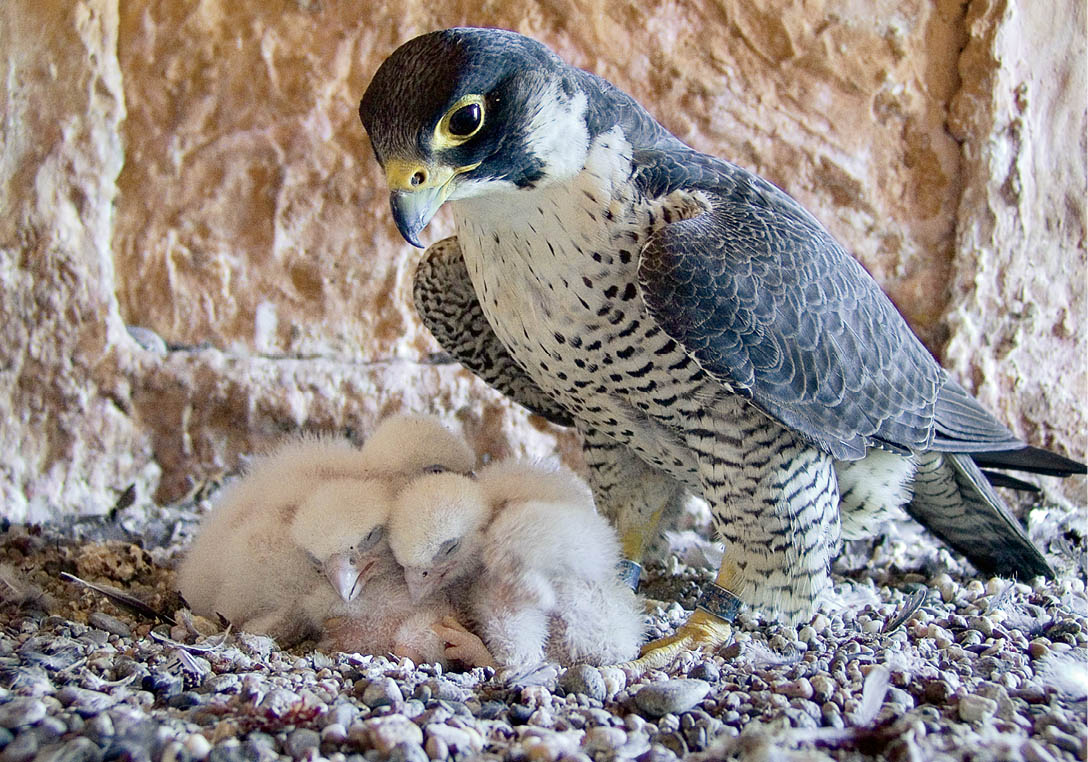
10–20 days old. Three Peregrine Falcon nestlings beg from their parent at their nest scrape on a rock ledge. Dark feathers are visible around the edges of their thick down. During the first few weeks, the adults tear the prey into pieces that the young can swallow and digest, leaving out any bones.
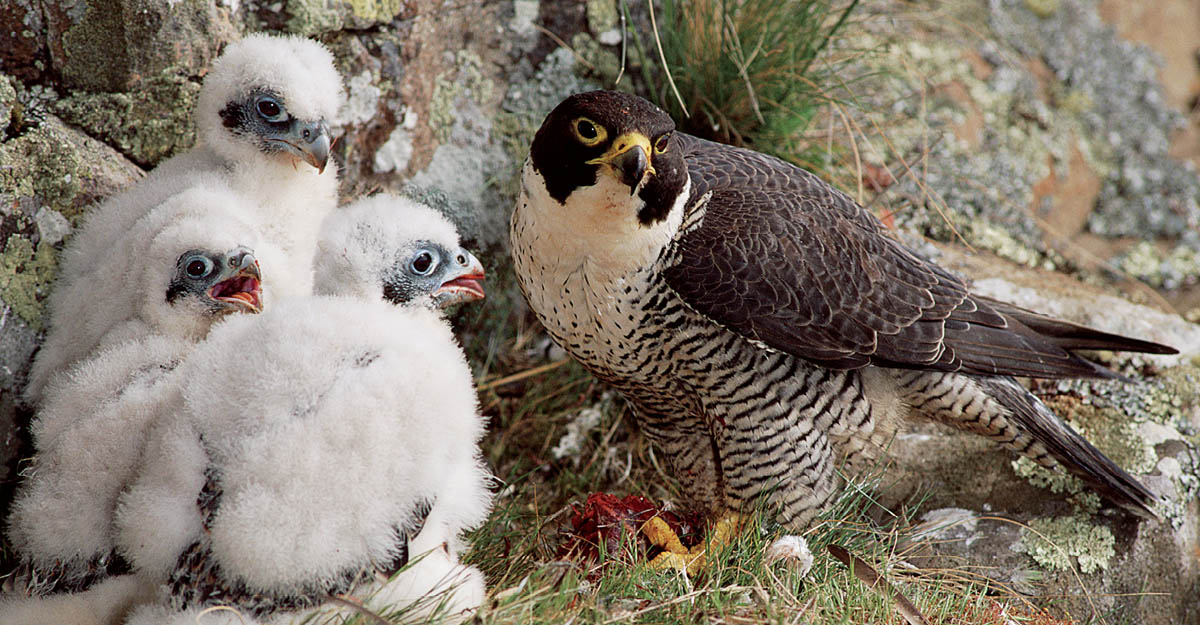
30–35 days old. A peregrine nestling, half feathered and half downy, exercises its wings while its two siblings watch. This nest, perhaps originally built by ravens, eagles, or Red-tailed Hawks, is tucked into a rock crevice.
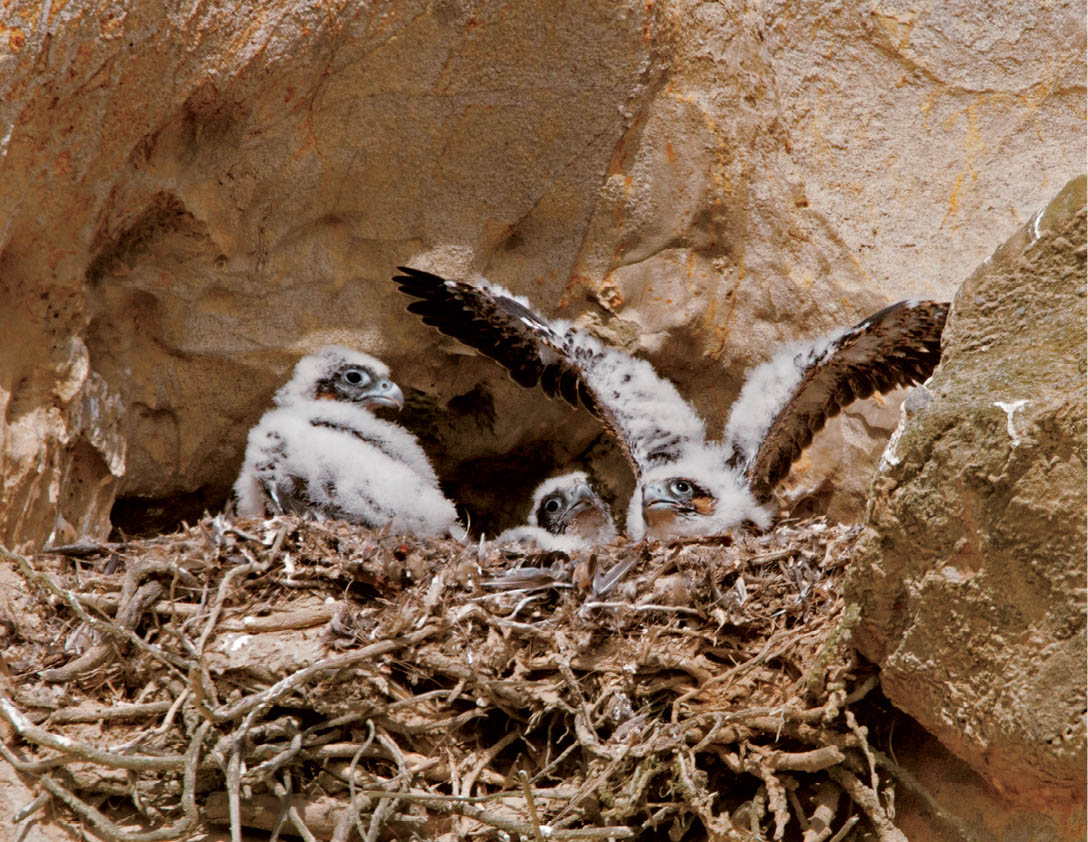
City Kids. The mother Peregrine Falcon delivers prey to her three noisily begging fledglings on a ledge below their nest on the Brooklyn Bridge. Urban peregrines eat pigeons, starlings, and other common species such as robins, jays, and doves.
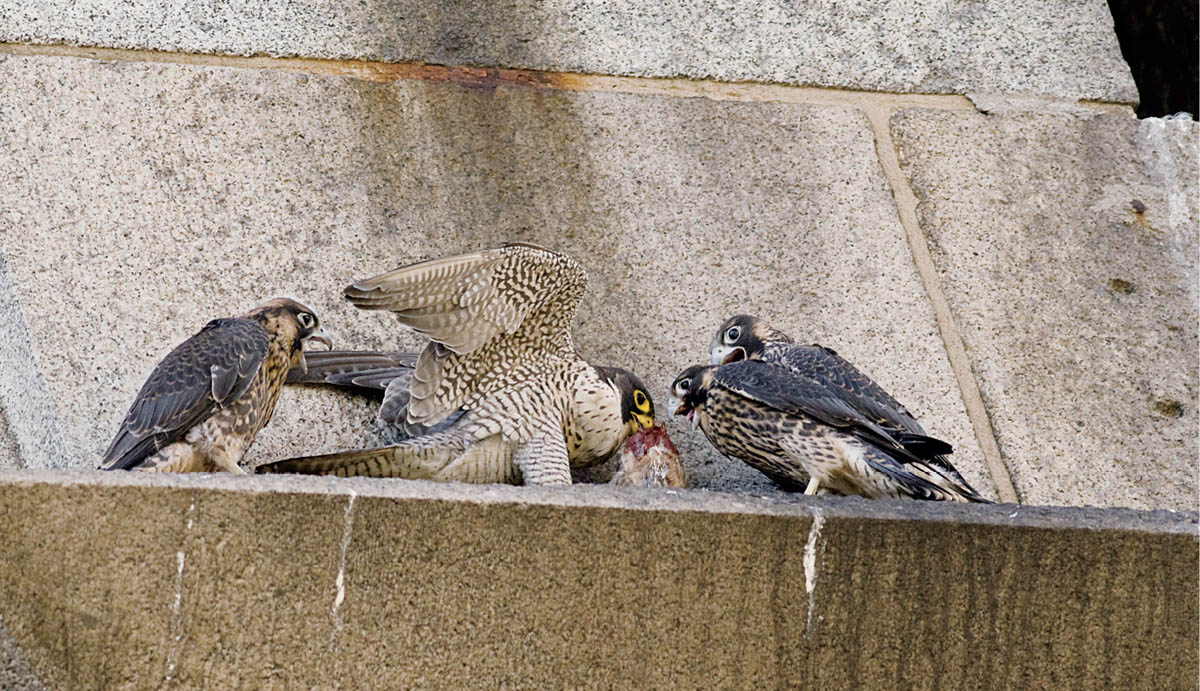
Peregrine Falcon young are semi-altricial, with no clear point when they change from nestlings to fledglings. Some chicks may wander away from the nest scrape at only 10 days old, but most remain close for at least 24 days. Perhaps to encourage exploration and movement, the parents often deliver food some distance from the chicks. In nestboxes on buildings, the young falcons may start clambering along windowsills and ledges, occasionally making tentative jumps. Peregrines make their first flight when 35 to 42 days old.
Females gain weight more rapidly than males, but males develop more quickly and usually fledge a few days to a week before their sisters. The males’ smaller size and greater dexterity help them avoid accidents; female fledglings are found grounded more often than males.
Within 10 days, the fledglings start pursuing their parents for food. As the young become more adept in flight, the parents start dropping both dead and live birds in midair. This may be part of basic training, or simply a way to protect themselves from the youthful, talon-wielding attackers.
Peregrine Falcon pairs usually remain mated as long as they both survive. One or both may migrate, but come nesting season, the two gravitate to the nest they’ve used in previous years. It’s up to each to defend its position at that nest against competitors of its own sex, but over time, peregrines learn every nook and cranny of the territory and grow increasingly skillful at defending it.